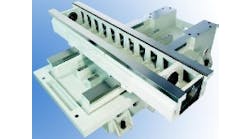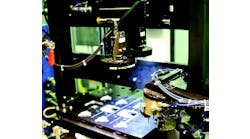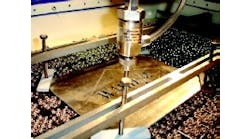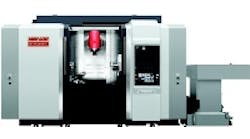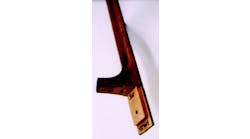The new NZ-S1500 two-turret CNC lathe is all about high-volume, small-shaft work involving everything from axle and cam shafts to ballscrews. The machine's special design shortens cycle times, allows for aggressive machining techniques and eliminates eating up large amounts of shop-floor real estate when incorporating multiple machines. All this adds up to a 20 percent increase in productivity compared with using conventional lathes, says the machine's manufacturer Mori Seiki (www.moriseiki.com)
Because of its compact size, the NZ does not waste time on long travels when performing such tasks as setting tailstocks and retracting for toolchanges. That contributes to slashed machine cycle times for shops that typically cut small shafts on conventional 2 or 4-axis lathes that have longer beds than necessary for such jobs.
To further reduce part cycle times, the NZ has a symmetrical design that lets shops machine shafts more aggressively than they could with conventional lathes. The design incorporates two opposing turrets, one above the machine's single spindle and the other directly below it. That symmetry increases machine accuracy during continuous machining, helps to manage thermal expansion and gives both turrets the same qualities in terms of strength and rigidity. It also makes aggressive shaft-machining techniques such as pinch and balance turning possible.
In pinch turning, one turret roughs while the other, stepped slightly behind at a different Z dimension, finish cuts. The two turrets machine two different diameters simultaneously and support each other because their opposing tool forces create a steadyrest environment without having to use a steadyrest.
Balanced turning, which has both the upper and lower tools cutting on the same diameter, lets shops crank up feedrates. This fine-tuned process is accomplished through the NZ's control.
According to Mori Seiki, many shops that produce shafts want to be able to see over machines to keep an eye on their turning operations while keeping machines grouped together, and they want to do that without using huge amounts of floor space. The NZ is 34 percent smaller than Mori Seiki's previous models and meets those requirements in all dimensions. It has a reduced width, depth and height, and its smaller size helps shops to increase productivity on a per-square-foot basis.
Also, to facilitate multiple-machine operations and reduce part-handling cycle times, Mori Seiki offers a special loader with a rotary-hand function that reverses workpieces and eliminates the need for a turnover unit when transferring parts from one operation to the next. With that loader, a line of two NZs uses 50 percent less of the connection space required by two full-size lathes.
To avoid production shutdowns and increase machine reliability, Mori Seiki completely covers its NZ guideways to prevent chips from entering the units or accumulating. The covers are set at 45-degree angles and direct scattered chips into machine chip pans located directly below the machining area.
The sequence of the NZ-S1500's loader eliminates the need for turnover units.
The NZ-S1500's symmetrical design features two opposing turrets.
NZ-S1500 specs
|

